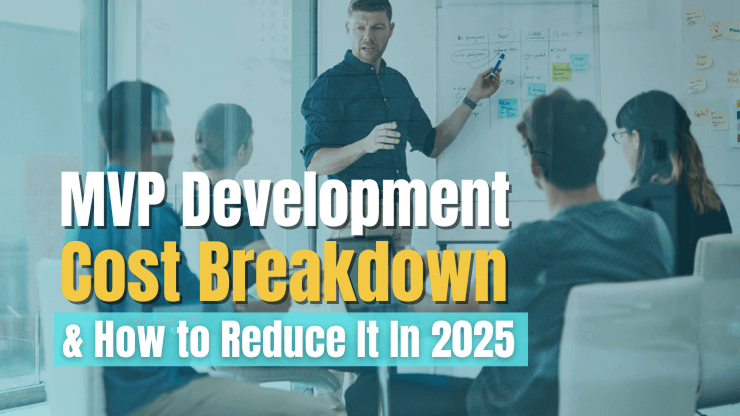Are you starting a software development project and looking for ways to accurately estimate the cost? The software development cost estimation process can be challenging, especially when you consider that 45% of software projects are over budget while delivering 56% less value. You may be wondering how to make sure that you don't fall into that same trap.
In this article, we’ll walk you through:
- 3 common software cost estimation techniques
- key software development costs factors
- a 6-step process for software budget estimation
By applying these insights, you can avoid software project cost estimation mistakes and set your software project on a solid path to success.
- Why is accurate software development cost estimation important?
- What are the main methods of cost estimation?
- 6 steps to accurately estimate software development costs
- Software development cost factors
- Average cost of software development
- Tips to prevent budget overruns
- Software development cost estimation template
- Conclusion
Why is accurate software development cost estimation important?
Software development cost estimation is notoriously difficult. Budget overruns are the norm more than the exception when it comes to software development projects. So why even bother trying to estimate the cost of software development at all? While no estimate will ever be 100% accurate, working towards an accurate-as-possible software cost estimation for your software project can help you:
- Manage stakeholder and client expectations by providing a realistic indication of the cost of the software project.
- Highlight areas of the budget that are driving costs up. From there you can look for ways to reduce costs such as finding an alternative technology or utilizing a different development team hiring strategy.
- Identify risks and opportunities early on in the software development process, allowing for better planning and decision-making.
- Ensure they have enough resources set aside for the software project at hand before kicking off work.
Depending on your priorities, you may want to set aside less or more time and resources to develop a software cost estimation. Sometimes a rough estimate is sufficient. Other times, it’s worthwhile to build a more accurate estimate by pulling together more detailed data points. It’s up to you to decide what’s important for your software cost estimation!
With that in mind, let’s take a look at the main methods to estimate software development cost, so you can find the one that suits your software project the best.
What are the main methods of cost estimation?

There are three main methods of software development cost estimation: parametric cost estimation, analogous cost estimation, and bottom-up cost estimation.
Each of these methods has its advantages and disadvantages and can be used in different situations to generate an accurate software cost estimation. By understanding the different methods of cost estimation, software project managers can make informed decisions about their project budget and timeline before software developers even begin their work.
Parametric cost estimation
Parametric cost estimation is a technique that uses a set of parameters or factors, such as the size of the project, the complexity of the project, the number of software developers, and the estimated duration of the project to generate development cost estimates for the project.
This type of software cost estimation is particularly useful when getting cost estimates quickly and is more important than having an accurate estimate, as its accuracy is heavily dependent on the scope of work and inputs being well defined - which may not be available at an early project stage.
However, if you do have a sophisticated estimation model available and have a very precise project scope defined, you’ll be more likely to get an accurate software development cost estimation.
Pros
- Can be used to compare different approaches to the same project
- Quick to perform
Cons
- Often too simple for complex projects
- Heavily dependent on accurate inputs
Analogous cost estimation
Analogous cost estimation is a technique that relies on historical data from similar projects to provide an estimate of a future project's cost. The historical data is used to find a software project similar to the one at hand and the cost associated with that project is used as a reference point. From there, adjustments are made to the reference point cost to reflect the differences between the current project and the historical project.
Pros
- Rapid estimates when similar past data is available
- Requires minimal upfront planning
Cons
- Potentially inaccurate if past projects aren’t truly comparable
- Can be affected by changing technology or market conditions
Bottom-up cost estimation
Bottom-up cost estimation is a technique used to estimate the cost and is based on the analysis of activities and tasks that need to be completed for the project. This type of software development cost analysis can be used for projects that are complex, requiring a high degree of accuracy.
The bottom-up estimation process begins by breaking down the project into smaller tasks and activities. For each task, the resources required and associated costs are estimated. These estimates are then aggregated to calculate the total development cost of the project. It is important to note that the more individual items you have broken your project into, the higher your estimate will be, as you will add some amount of cost “buffers” to each individual item. The more buffers added, the higher the estimate.
Overall, this cost estimation method is flexible, allowing a development team to scale up or down the work required based on how detailed they need their estimate to be. If a high level estimate is sufficient, you could break your project into a few large buckets of tasks. Or, if a more accurate or detailed estimate is required, you could break things down into subtasks.
Pros
- Offers the highest accuracy through detailed breakdowns
- Flexible enough to match any level of scope detail
Cons
- Time-consuming (requires thorough task-level analysis)
- Prone to overestimation if multiple "buffers" are added
6 steps to accurately estimate software development costs
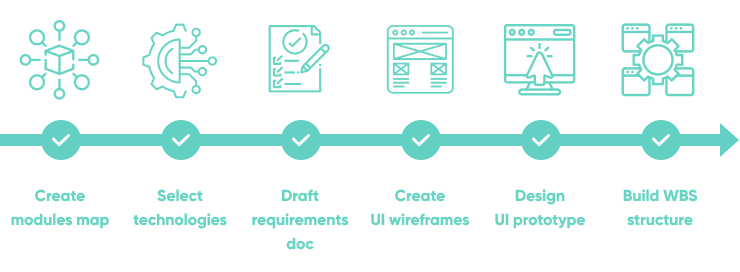
Accurately estimating the software development cost is essential to the success of any project. Without a sound financial plan, it is easy to overspend and cause significant delays to your project. And, as we have seen, there are a few main methods for estimating the cost of software development. Depending on your project, you may find that one method is more suitable than another.
The 6 step process below blends techniques from parametric and bottom-up estimation techniques to provide teams an accurate way to put together a software development cost breakdown for any project.
Create a project brief and high-level modules map
When it comes to estimating the cost of developing software, it is important to begin with a high-level understanding of the project at hand. If you do not already have one, write up a project brief that describes the purpose of the software product, its audience, and its basic functionality.
From there, describe the modules involved in the project as well as their dependencies. A high-level map of the modules and their features will help you to understand the scope of the project and give you a good basic understanding on which you can build a more detailed software development cost estimate.
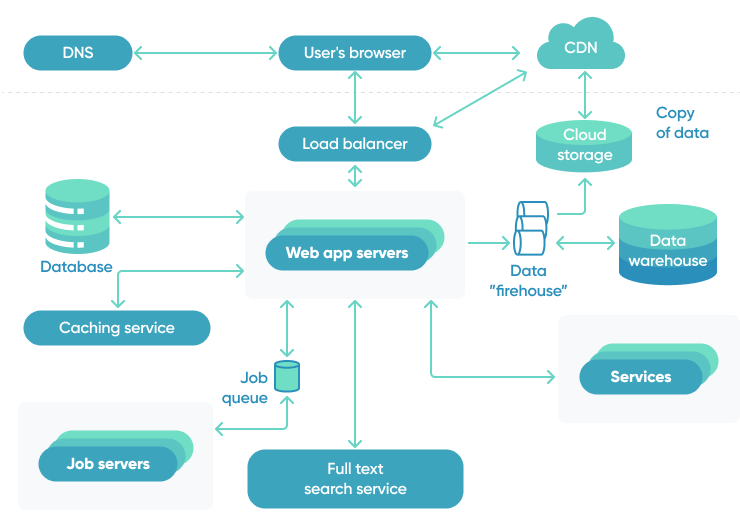
As you put together a module map, make sure to take into account:
- Databases
- User interface
- Infrastructure
- Feature-specific modules
- 3rd party integrations
Next, consider the different dependencies between these modules, such as how each module relies on other modules or how the modules need to be tied into other systems.
Research and select technologies
Once you have created a high-level map of the modules and their dependencies, the next step is to research the technologies that are most suitable for your project.
If you have one or more technologies that you know you’d like to use (or that are simply required), it’s important to work with your software development team to conduct additional validation work at this stage to ensure that they are actually suited for your project.
There may also be other technologies that are more flexible. For example, you may be able to utilize “building blocks” such as open-source or commercial components or services to speed up your software development project and keep costs down. This is a good time to research these and select the most appropriate and cost effective options.
When researching technologies, consider the following:
- What technologies are required for your project?
- What open-source or commercial components are a good fit for the project?
- How quickly will you be able to build your software solution with the technologies you’re considering?
Draft software requirements specification (SRS) document
Before you can accurately estimate software costs, you need to create a Software Requirements Specification. This document should outline at a high level:
- Product summary and scope
- Intended audience
- Assumptions and dependencies
- Functional requirements (what the system is supposed to do)
- Non-functional requirements (how the system should perform)
- Acceptance criteria
By creating an SRS, you can ensure that all members of the project team and all other stakeholders have a clear understanding of the project requirements.
The SRS document is also a valuable tool for prospective vendors, as it will allow them to create more detailed estimates. By providing a complete and detailed SRS, vendors can identify the scope of the project and the potential costs involved.
Create low-fidelity UI wireframes
Creating low-fidelity UI wireframes is a great way to improve the accuracy of your cost estimates with only a moderate time investment. By sketching out your desired interface, your software development outsourcing company (or internal team) can get a better idea of what you intend to build, and therefore, help you build a more accurate development budget.
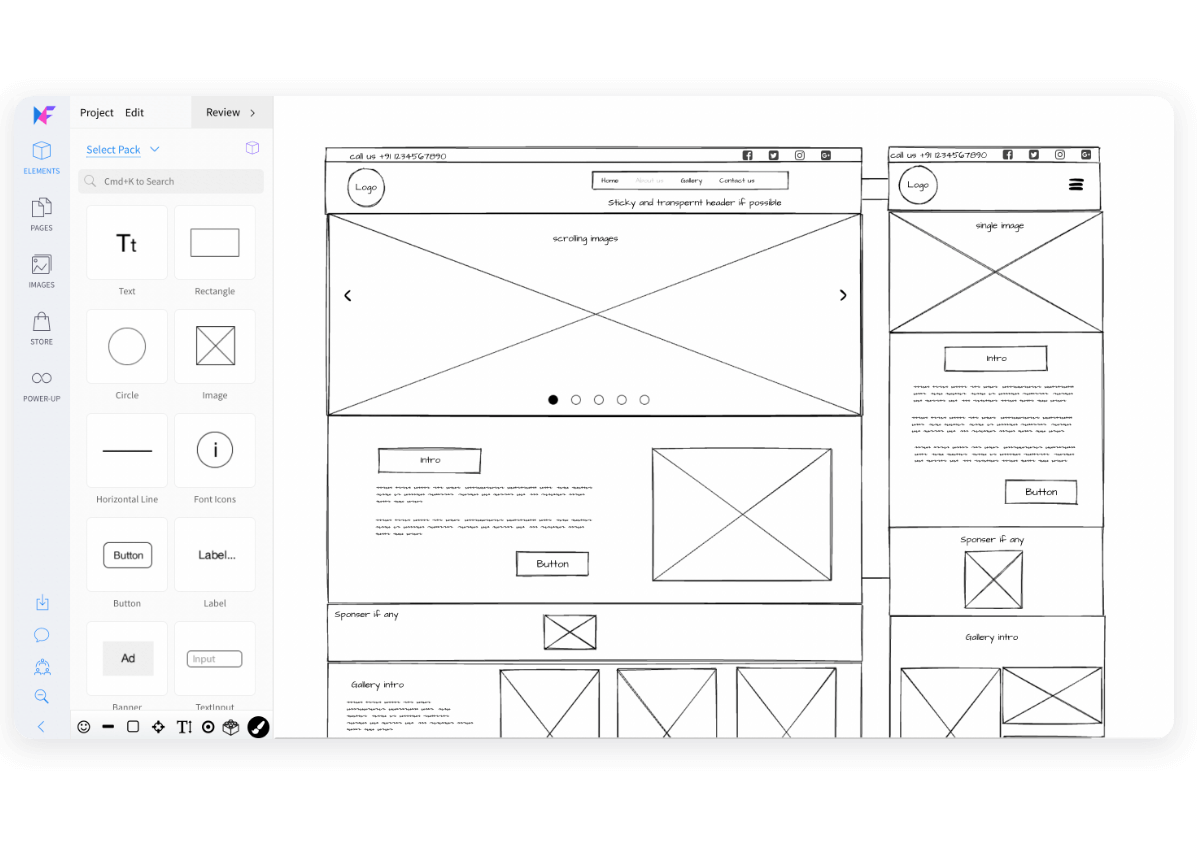
While wireframes can be a helpful tool to improve the accuracy of your cost estimate, there is a risk that the software vendor will treat the wireframes as though they are completely “locked in” and not able to be modified at all. It’s very important to clarify with your development team that your wireframes are a very early version of your product and can be modified.
Design high fidelity UI prototype
If you’d like to improve the accuracy of your estimate, we recommend you build on your low-fidelity wireframes and create a high-fidelity UI prototype. You can also think about this as another phase in your estimation process - a means to get a new, more accurate version of your project estimate.
Creating high fidelity UI prototypes can provide a more accurate representation of the user experience, as well as the technical complexity of the project. This can help stakeholders get a better understanding of the scope of the project, and developers can gain insights into the design and development process.
Additionally, having a high fidelity prototype can help to identify technical issues and UI design flaws that may have gone unnoticed during the early stages of design. This in turn can help to reduce project costs and ensure the project is delivered on time.
Create a work breakdown structure (WBS)
Another way to improve the accuracy of your estimate is to put together a work breakdown structure (WBS). Essentially, a WBS lists all of the tasks required to complete the project along with an estimate of the cost of each task.
The level of detail of your WBS is up to you. Teams can create anything from a high-level WBS (like the one shown below) to a low-level WBS that breaks tasks down into a detailed list of sub-tasks. When in doubt, aim for something in the middle that will provide you a reasonable level of accuracy without risking overestimation that can sometimes occur if you try to make it too detailed.
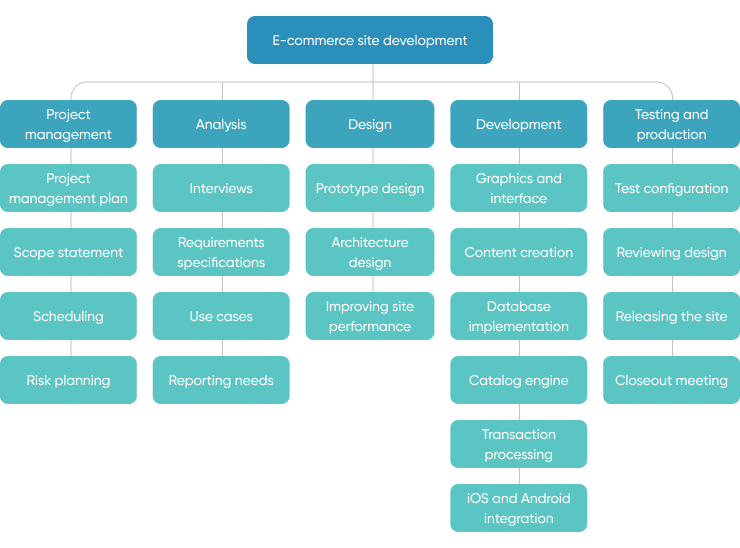
A work breakdown structure should:
- Be put together either by or in tandem with your software development company. The people actually doing the work must be involved or it will not be accurate.
- Help your project manager or development team to build a project timeline.
- Provide a way for teams to monitor progress and keep an eye on tasks that may be at risk for running over budget.
Software development cost factors

As you build your own software development project estimate, you’ll find that there are many factors that can drastically affect the overall cost. Of course, the complexity of the project will be a driver of cost, but other factors can be at play as well. Let’s take a look at the key factors that can affect the cost of your software development project:
Research and planning
Regardless of the complexity of your software product, you will need to do some level of research to help you define exactly what it is you want to build and how you want to build it. While every software development project will require some level of research and planning, the scope of work can vary significantly.
Technology choices
Technology choices can certainly affect your software development cost. When considering various technologies, developers must take into account the long-term costs associated with maintaining the technology, as well as the cost of training staff to use the technology.
Choosing an open-source technology can be an effective way to reduce upfront costs, but the cost of maintenance must be taken into consideration as well. Similarly, choosing an off-the-shelf technology can reduce development time, but the license costs should be taken into account.
PRO TIP: At SoftKraft we use a highly efficient boilerplate approach, which sits between fully custom development and off-the-shelf solutions:
- We have built pre-configured modules such as authentication, subscriptions, user management, and role-based access control (RBAC).
- We pair these core modules with a ready-to-use UI design system, letting you launch a functional product in just a matter of weeks.
Contact us and discover how it can give your project a powerful head start!
Complexity of the project
It may seem obvious, but the cost of developing a software product is closely related to its complexity. Complex software requires more time and resources to develop, as it involves more intricate coding, more complicated testing, more robust security, and more complex user interface design. This can result in a significantly longer development cycle and higher costs.
UI/UX requirements
UI/UX requirements can have a significant impact on the software development cost. The amount of work and resources that go into the design - both the user interface (UI) and user experience (UX) - can be significant. You should ensure you are properly scoping this out if you want to estimate project cost accurately.
Hiring model
Consider who will be supporting the development of your software product. Will you be working with an in-house team, freelance developers you hire and manage, or perhaps a full-service dedicated development team hired through an outsourcing company? The hiring model you choose will affect the software costing estimation.
Development team location
If you’re outsourcing your development project, you should consider the location of the software development company or freelancers you hire. The location of your developers can dramatically impact the rates you pay. Generally, we can divide software developer locations into four categories:
- Asia/India ($25-40/hr): Tends to be the cheapest option; however, you may find the cultural differences, time zones, and development quality may not meet your needs.
- Eastern Europe ($35-60/hr): Has become a popular region for development due to its relatively low labor costs and access to a large pool of highly-skilled developers.
- Western Europe ($60-80/hr): Generally more expensive than Eastern Europe due to higher labor costs; however it may be the right option for some.
- US ($80-100+/hr): One of the most expensive places in the world for software development; however, teams would have access to a large pool of highly-skilled software developers.
Support and maintenance
Support and maintenance can significantly impact the cost of software development. Without proper monitoring, on-call support, and technical improvements, the software developed can quickly become outdated and expensive to maintain.
When comparing quotes from vendors, don’t forget to consider costs that may be necessary post-launch, including performance monitoring, on-call support, and long-term technical improvements.

Average cost of software development
The cost of software development can vary widely. Factors such as the scope of the features, complexity of the UI design, platforms selected, technologies required, and the integrations required can all impact the custom software development cost.
However, in general, we can break down software development projects into three main categories. You can get a ballpark for you own project by viewing the estimate spreadsheets for each:
Simple software
Limited, core feature set with minimal third-party integrations; simple UI/UX; likely optimized for a single platform.
- Time frame: 1-2 months
- Cost range: $5k - $15k USD
Medium complexity software
More robust features; potentially more complex or custom UI/UX; may include third-party integrations; possibly multiple platforms.
- Time frame: 2-6 months
- Cost range: $15k - $45k USD
High complexity software
Multiple intricate features or components; advanced data processing and analytics; likely enterprise-level requirements; may require extensive third-party integrations.
- Time frame: 6+ months
- Cost range: $50k+ USD
These figures are ballpark estimates that will vary based on your exact requirements, the specific technologies used, and the level of customization required.
Tips to prevent budget overruns
Software development projects can be complex and costly, so it’s no wonder that many companies are looking for ways to not only estimate their project budget accurately but also to prevent budget overruns throughout the project. To help prevent such overruns, we recommend you:
- Align on project scope early: The fastest way to go over budget is to change the scope of your project. As much as possible, get all stakeholders and management to align on the project’s scope before development begins.
- Consult with an experienced vendor: A software development company will be able to use their years of experience in the industry to help you hone in on a more accurate project estimate.
- Plan for the unexpected: Include contingencies in the budget for any unexpected costs or delays.
- Define project milestones: Break the project into smaller deliverables and milestones and set targets for each of these.
- Monitor progress and costs: Regularly review the progress of the project and the associated costs, and as project parameters change, update your estimate.
- Use proven development strategies: Adopt proven development strategies such as agile, scrum, and DevOps to increase efficiency and reduce costs.
Software development cost estimation template
Ready to begin your own estimation work? Get a copy of the software development cost estimation template here!
Inside the template, you’ll find the following fields:
- Requirement: A short, descriptive label for the feature or deliverable.
- Estimate (resources): Number/roles of people or team hours required.
- Estimate (cost $K): The corresponding cost in thousands of dollars.
- Priority: Must-have vs. nice-to-have.
- Assumptions: Key factors you’re taking for granted (e.g., third-party APIs, client-provided content).
- Risks & Unknowns: Potential areas of uncertainty or complexity (e.g., untested integrations)
- Comments: Extra notes or clarifications regarding scope or context.
Conclusion
Software development cost estimation is a difficult process, but it is essential to the success of any project. By following a 6-step estimation process you’ll be better prepared to create a realistic software project budget and timeline.
Need a software development cost estimation? Contact us today to discuss your project and discover how our boilerplate approach helps reduce costs, speed up delivery, and give you the flexibility to adapt as your product evolves.


